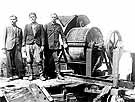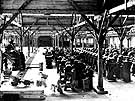
|
|
|

|

|

|

|
|
Click on an image to see a larger, more detailed picture.
|
|
|
|
|
| 1943: Death and Resistance |

|
pg. 487 |

|
|
|
|
| |
 When the war turned against the Germans, they began a concerted effort to conceal their crimes. Hence, Sonderkommandos, most of them Jews, were ordered to begin the grisly task of exhuming the bodies of Nazi Germany's millions of victims and disposing of the remains. This photograph shows a bone-crushing machine that was used to grind up the body parts that could not be burned. The man on the right, with the surname of Korn, burned about 46,000 corpses, including that of his wife, during the three months he worked as a Sonderkommando.
When the war turned against the Germans, they began a concerted effort to conceal their crimes. Hence, Sonderkommandos, most of them Jews, were ordered to begin the grisly task of exhuming the bodies of Nazi Germany's millions of victims and disposing of the remains. This photograph shows a bone-crushing machine that was used to grind up the body parts that could not be burned. The man on the right, with the surname of Korn, burned about 46,000 corpses, including that of his wife, during the three months he worked as a Sonderkommando.
Photo: Central State Archive of Film, Photo and Phonographic Documents / United States Holocaust Memorial Museum Photo Archive
|
 Prisoners from the Buchenwald, Germany, concentration camp staffed this assembly line at the Gustloff Werke II munitions plant. The Gustloff Werke facility was built in 1943 and was one of the main armaments factories at Buchenwald. The armaments complex was staffed by 3600 prisoners. The particularly sadistic treatment of the prisoners at the hands of their Nazi guards resulted in a very high death rate.
Prisoners from the Buchenwald, Germany, concentration camp staffed this assembly line at the Gustloff Werke II munitions plant. The Gustloff Werke facility was built in 1943 and was one of the main armaments factories at Buchenwald. The armaments complex was staffed by 3600 prisoners. The particularly sadistic treatment of the prisoners at the hands of their Nazi guards resulted in a very high death rate.
Photo: Nationale Mahn- und Gedenkstätte Buchenwald / United States Holocaust Memorial Museum Photo Archive
|
 Josef Glazman was the deputy commander of the Vilna (Lithuania) Ghetto police and the leader of the Betar youth group. His negotiations with the leaders of Jewish youth groups produced a unified Resistance faction known as the FPO (United Partisans Organization). Glazman was responsible for gathering intelligence about the German and Lithuanian forces, training new recruits, and organizing housing within the ghetto. He was killed in a gunfight with the Germans in the Naroch Forest in October 1943.
Josef Glazman was the deputy commander of the Vilna (Lithuania) Ghetto police and the leader of the Betar youth group. His negotiations with the leaders of Jewish youth groups produced a unified Resistance faction known as the FPO (United Partisans Organization). Glazman was responsible for gathering intelligence about the German and Lithuanian forces, training new recruits, and organizing housing within the ghetto. He was killed in a gunfight with the Germans in the Naroch Forest in October 1943.
Photo: Yad Vashem / United States Holocaust Memorial Museum Photo Archive
|
|

|

|

|

|
 October 7, 1943: One thousand Jews are deported from Paris to their deaths at Auschwitz.
October 7, 1943: One thousand Jews are deported from Paris to their deaths at Auschwitz.
|
 October 8, 1943: On the eve of the Jewish Day of Atonement, several thousand ill or weak Jewish men are gassed at Auschwitz.
October 8, 1943: On the eve of the Jewish Day of Atonement, several thousand ill or weak Jewish men are gassed at Auschwitz.
|
 October 8, 1943: Three thousand Italian prisoners of war are murdered by the SS and Ukrainian guards at La Risiera di San Sabba, Italy, south of Trieste. Of 1920 Jews in Trieste, 620 are murdered by the SS.
October 8, 1943: Three thousand Italian prisoners of war are murdered by the SS and Ukrainian guards at La Risiera di San Sabba, Italy, south of Trieste. Of 1920 Jews in Trieste, 620 are murdered by the SS.
|
 October 10, 1943: A non-Jewish Latvian named Yanis Lipke rescues three Jews in Riga by offering ghetto guards two packs of cigarettes for "some Yids to work in my kitchen garden"; See October 11, 1943.
October 10, 1943: A non-Jewish Latvian named Yanis Lipke rescues three Jews in Riga by offering ghetto guards two packs of cigarettes for "some Yids to work in my kitchen garden"; See October 11, 1943.
|
 October 10, 1943: At the Sobibór death camp, a revolt is planned by Jewish laborers and Jewish Red Army POWs; See October 13, 1943.
October 10, 1943: At the Sobibór death camp, a revolt is planned by Jewish laborers and Jewish Red Army POWs; See October 13, 1943.
|
 October 11, 1943: One day after rescuing three Jews from the Riga (Latvia) Ghetto by asking guards for Jews to labor on his property, Yanis Lipke rescues additional Jews with the same ruse.
October 11, 1943: One day after rescuing three Jews from the Riga (Latvia) Ghetto by asking guards for Jews to labor on his property, Yanis Lipke rescues additional Jews with the same ruse.
|
|
|
|
|
| 1943: Death and Resistance |

|
pg. 487 |

|
|
The Holocaust Chronicle
© 2009 Publications International, Ltd.
|
|
